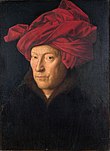Portrait of a Man (Self Portrait?)
| Portrait of a Man (Self portrait?) | |
|---|---|
 | |
| Artist | Jan van Eyck |
| Year | 1433 |
| Type | Oil on panel |
| Location | National Gallery, London |
The Portrait of a Man (Self Portrait?),[1] also often known as Portrait of a Man in a Turban, or in a red turban, etc, is an oil painting by the Early Netherlandish master Jan van Eyck, from 1433. It has been in the National Gallery, London since 1851, having been in England since Thomas Howard, 21st Earl of Arundel acquired it, probably during his exile in Antwerp from 1642-44.[2]
The original frame survives (the vertical sides are in fact a single piece of wood with the central panel), and has the painted inscription JOHES DE EYCK ME FECIT ANO MCCCC.33. 21. OCTOBRIS ("Jan Van Eyck Made Me on October 21, 1433") at the bottom and at the top the motto AlC IXH XAN ("I Do as I Can"), which appears on other van Eyck paintings, always written in Greek letters, and includes a pun on his name. As on other van Eyck frames, the letters are painted to appear carved.
Like all Van Eyck's portraits, it shows a sharp and detailed analysis of the physical lines. It is however without any treatment of the subject's thoughts and moods. The subject is often thought to be van Eyck himself, though there is no direct evidence for this. The costume is appropriate for a man of van Eyck's social position, and the motto is his personal one, otherwise only appearing on two surviving religious paintings, two more known only from copies, and the portrait of his wife. In none is it as prominent as here.
He is not in fact wearing a turban, but a chaperon with the ends that normally hang down tied up over the top, which would be a sensible precaution if it was worn whilst painting. A similar chaperon is worn by a figure in the background of van Eyck's Rolin Madonna, and it has also been suggested that this is a self-portrait.
Typically for van Eyck, the head is a little large in relation to the torso. The technique shows the "skill, economy and speed" of van Eyck's best work.[3] Campbell describes the painting of the left eye as follows: "The white of the eye is laid in white mixed with minute quantities of red and blue. A very thin scumble of red is brought over the underlayer, which is, however, left exposed in four places to create the secondary highlights. The veins are painted in vermilion into the wet scumble. The iris is ultra-marine, fairly pure at its circumference but mixed with white and black towards the pupil. There are black flecks near the circumference and the pupil is painted in black over the blue of the iris. The principal catchlights are four spots of lead white applied as final touches, one on the iris and three on the white, where they register with the four secondary lights to create the glistening effect."[3]
References
- ^ The title now used by the National Gallery. Campbell, Lorne; National Gallery Catalogues (new series): The Fifteenth Century Netherlandish Paintings, pp 212-17, 1998, ISBN 185709171
- ^ It was noted in Arundel's collection in Antwerp by a Flemish visitor, as a portrait of the "Duke of Barlaumont". Campbell op cit. p 212.
- ^ a b Campbell op cit p. 216

